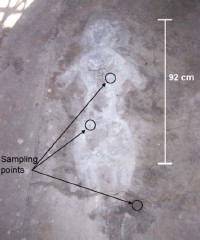
A stain, shaped like a human body, can be found on the concrete floor of the Athens Mental Health and Retardation Center in Athens Ohio. According to legend, this stain marks the location where the body of a patient, Margaret Schilling, lay undiscovered for several weeks back in 1979.
A team of forensic scientists recently tested the stain to determine whether it's a genuine human decomposition stain, or if it was created artificially. They published the results of their investigation in the Nov 2008 issue of the Journal of Forensic Sciences (vol 53, no. 6),
"Analysis of Suspected Trace Human Remains from an Indoor Concrete Surface."
Their conclusion: Yes, it's a human decomposition stain, although the stain has been made more prominent over the years by attempts to remove it:
Margaret’s body was probably in contact with the area of the stain for a period of 4–5 weeks. During this time, significant decomposition is known to have occurred, indicating that the room was apparently warm enough to facilitate bacterial degradation. During this time, anaerobic bacterial decomposition could have taken place in the contact areas between the concrete and the heavier, fatty areas of Margaret’s body, such as the buttocks, back and shoulders. Bacterial action is supported by the oddnumbered fatty acids found in the residues. Such decomposition, facilitated by the moisture naturally present in Margaret’s body, formed free fatty acids from the lipids in her subcutaneous tissue. This process may have been accompanied, in part or in whole, by the basic conditions provided through contact with the concrete. During the 4- to 5-week period in which the free fatty acids were being formed, and in any subsequent washing over the years, at least half of the sodium ions were displaced by calcium ions from the concrete. The result is a waxy residue of mostly calcium palmitate which is up to 2 mm thick in certain areas of the stain.In most areas of the stain, the waxy residue also resides in surface pores in the concrete, consistent with the suggestion that removal of the stain was attempted on at least one occasion.
At some point since the removal of Margaret’s remains in January of 1979, the floor has likely been treated with an acidic chemical— probably Blu-Lite (20.5% phosphoric acid)—to lighten the color of the waxy residue and of the concrete. The chemical etching was not uniform across the entire floor surface, however, but was selectively restricted to a shape that resembled the apparent outline of a human body.
What a great way to be remembered -- by the stain you left on the floor. (via
Legends & Rumors)

 A stain, shaped like a human body, can be found on the concrete floor of the Athens Mental Health and Retardation Center in Athens Ohio. According to legend, this stain marks the location where the body of a patient, Margaret Schilling, lay undiscovered for several weeks back in 1979.
A stain, shaped like a human body, can be found on the concrete floor of the Athens Mental Health and Retardation Center in Athens Ohio. According to legend, this stain marks the location where the body of a patient, Margaret Schilling, lay undiscovered for several weeks back in 1979.
Comments
"On December 1, 1978, 53-year-old Margaret Schilling